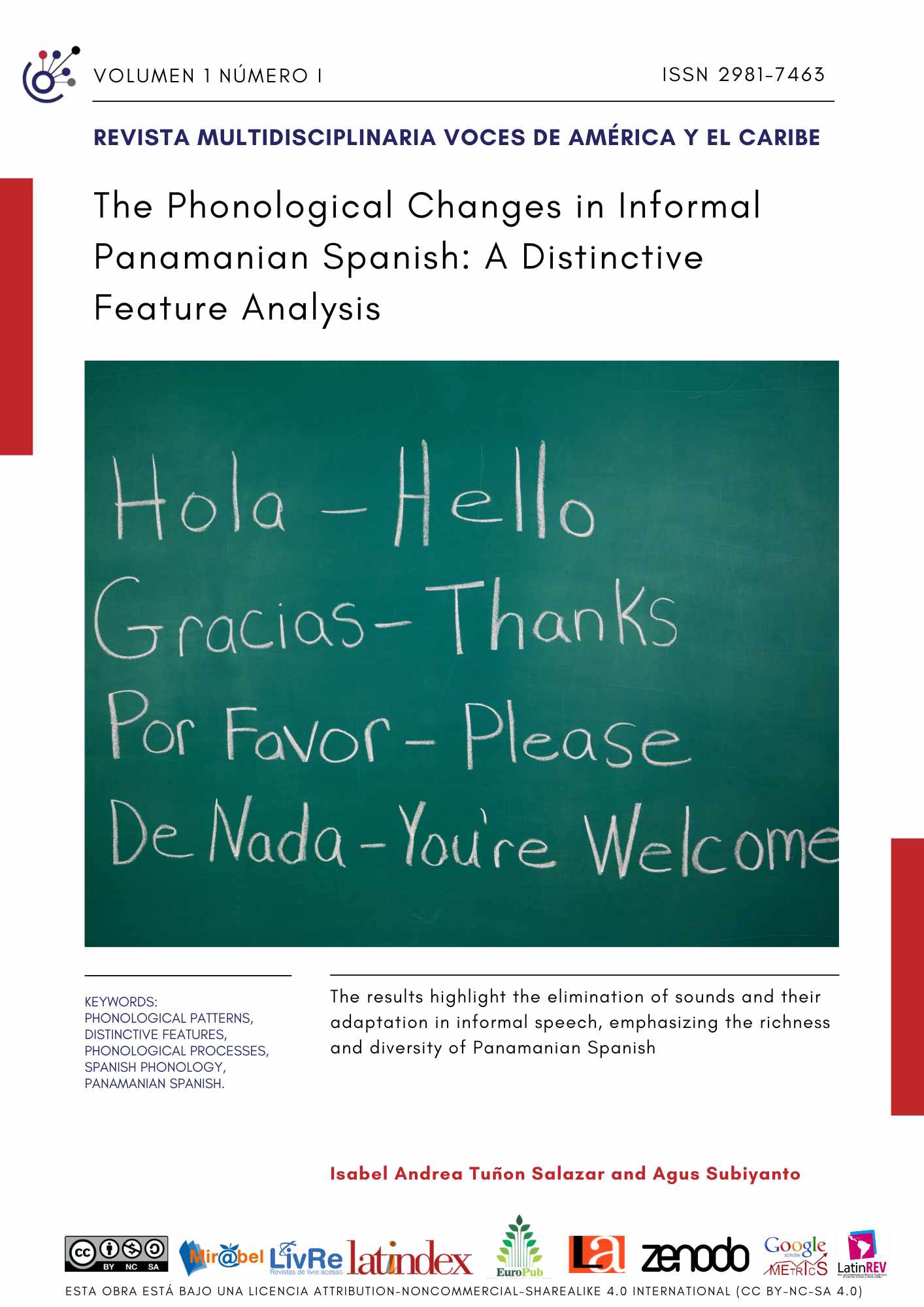The Phonological Changes in Informal Panamanian Spanish: A Distinctive Feature Analysis
DOI:
https://doi.org/10.5281/zenodo.11390912Keywords:
Phonological Patterns, Distinctive Features, Phonological Processes, Spanish Phonology, Panamanian Spanish PhonologyAbstract
Context: This article addresses the phonological changes in informal Panamanian Spanish, analyzing the distinctive features and underlying forms of phonological variations. The main objective is to examine the articulation patterns of native speakers and how these reflect linguistic evolution in Panama. The methodology includes a purposive sampling strategy, individual interviews, and the use of a standardized word list for data collection. Through distinctive feature analysis, prevalent phonological processes such as elision, assimilation, and prothesis were identified. The results highlight the elimination of sounds and their adaptation in informal speech, emphasizing the richness and diversity of Panamanian Spanish. The most relevant conclusion is that these phonological variations not only reflect the influence of other languages and cultures but also the cultural and social identity of the speakers. This study contributes to the preservation of linguistic diversity and provides a deeper understanding of phonological changes in Panamanian Spanish.
Downloads
References
Aatlo, Y. A. (2021). Prestigio, afecto e identidad: las actitudes lingüísticas en Panamá. [Master Thesis, The Arctic University of Norway] UiT munin. https://munin.uit.no/handle/10037/23809
Cedergren, H. (1973). The interplay of social and linguistic factors in Panamá. Tesis Doctoral, Ithaca, N.Y.: Cornell University.
Cedergren, H. (1979). La elisión de la /d/: un ensayo de comparación dialectal. Boletín de la Academia Puertorriqueña de la Lengua Española VII: 19-29
Chomsky, N. and Halle. (1968). The Sound Pattern of English. New York: Harper and Row.
Chomsky, N., & Halle, M. (1968). The Sound Pattern of English. Harper & Row.
Clark, J., & Yallop, C. (1990). An Introduction to Phonetics and Phonology (2nd ed.). Oxford: Blackwell Publishers Ltd.
D´Introno, Francesco & Juan Manuel Sosa. 1986. Elisión de la /d/ en el español de Caracas: aspectos sociolingüísticos e implicaciones teóricas. En Rafael Núñez Cedeño, Iraset Páez Urdaneta & Jorge M. Guitart (eds.), Estudio sobre la fonología del español del Caribe, 35-163. Caracas: La Casa de Bello.
Halle, M., & Clements, G. N. (1983). In Problem Book in Phonology: A Workbook for Introductory Courses in Linguistics and in Modern Phonology (pp. 6–8). essay, M.I.T. Press.
Labov, W. (1972). Sociolinguistic Patterns. University of Pennsylvania Press.
Labuschagne, A. (2003). Qualitative Research - Airy Fairy or Fundamental?. The Qualitative Report, 8(1), 1-4. https://doi.org/10.46743/2160-3715/2003.1901
Lapesa, R. (1981). Historia de La Lengua Española. Madrid: Gredos.
Malaver, I., & Perdomo, L. (2017). La elisión de /d/ en posición intervocálica en la comunidad caraqueña. Boletín De Filología, 51(2), 147–179. Recuperado a partir de https://boletinfilologia.uchile.cl/index.php/BDF/article/view/44868
McCarthy, John J., and Smith, Norval, (2003). Phonological Processes: Assimilation. Oxford International Encyclopedia of Linguistics. 20. Pp. 320 – 322. https://scholarworks.umass.edu/linguist_faculty_pubs/20
Miguel Ángel (eds.). Actitudes lingüísticas de los hispanohablantes hacia el idioma español y sus variantes, Bergen Language and Linguistic Studies (BeLLS), 5. http://dx.doi.org/10.15845/bells.v5i0.690
Millward, C. M. (1996). A Biography of The English Language (2nd ed.). New York: Harcourt Brace College Publ.
Munro, M. J., & Derwing, T. M. (1995). Processing time, accent, and comprehensibility in the perception of native and foreign-accented speech. Language and Speech, 38(3), 289-306. https://doi.org/10.1177/0023830995038003
Navarro, M. (1983). La variación del segmento /d/ en Puerto Cabello. Boletín de la Academia Puertorriqueña de la Lengua Española 9: 65-72. https://dialnet.unirioja.es/servlet/articulo?codigo=2763399
Navarro, M. (1995). El Español Hablado en Puerto Cabello. Valencia: Ediciones de la Universidad de Carabobo.
Palinkas, L. A., Horwitz, S. M., Green, C. A., Wisdom, J. P., Duan, N., & Hoagwood, K. (2015). Purposeful sampling for qualitative data collection and analysis in mixed method implementation research. Administration and Policy in Mental Health and Mental Health Services Research, 42, 533-544. https://doi.org/10.1007/s10488-013-0528-y
RAE. (2016, December 9). Elementos compositivos, prefijos y Sufijos (RAE). Studylib.es. Retrieved December 2022, https://studylib.es/doc/5301294/elementos-compositivos--prefijos-y-sufijos--rae-.d.).
Real Academia Española y Asociación de Academias de la Lengua Española. (n.d.). Diccionario panhispánico de dudas (DPD) [online]. https://www.rae.es/dpd/español, 2.ª edición (versión provisional).
Real Académica Española: Diccionario de La Lengua Española, 23rd ed., (online versión 23.6). https://dle.rae.es.
Rosero, M. I. (2017). Influencia de las variedades diatópicas de nuestros hermanos colombianos y venezolanos en estudiantes panameños de la universidad americana [Congreso Internacional SICELE]. Evaluación y variedad lingüística del español. Alcalá University, Spain. https://cvc.cervantes.es/ensenanza/biblioteca_ele/sicele/sicele03/007_rosero.htm
Tinoco, T. (2014). Actitudes lingüísticas en Panamá. Incursión en la percepción sociolingüística y la valoración de la lengua por los hispanohablantes panameños. In Chiquito, Ana Beatriz y Quesada Pacheco.
Un. (n.d.). Collins Spanish Dictionary-Complete and Unabridged 8th Edition. (2005). Retrieved December 2022 from https://es.thefreedictionary.com/un
Zamora Vicente, Alonso. (1970). Dialectología Española. Madrid: Gredos

Published
Issue
Section
License
Copyright (c) 2024 Isabel Andrea Tuñon Salazar, Agus Subiyanto

This work is licensed under a Creative Commons Attribution-NonCommercial-ShareAlike 4.0 International License.
Voces de América y el Caribe adheres to the Creative Commons Attribution-NonCommercial-ShareAlike 4.0 license. Under this license, others are allowed to remix, tweak, and build upon your work non-commercially, as long as they credit you for the original creation. Their new works must be under an identical license as the one that covers the original work. For more details on this license, please visit https://creativecommons.org/licenses/by-nc-sa/4.0/.
By publishing in our journal, authors agree to these conditions where others may share, use and adapt their work, as long as it is done non-commercially and with proper attribution given to the original work published in Voces de América y el Caribe.























